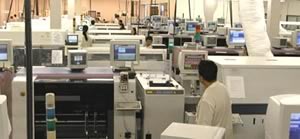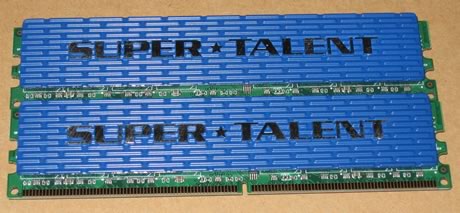1. Introduction
 Headquartered in San Jose, California, Super Talent designs and manufactures DDR and DDR2 memory modules and Flash based storage devices for computers and consumer electronics. Counting 20 years of Memory Industry experience, Super Talent relies on technical research and its commitment to product development to deliver leading edge memory products to the market.
Headquartered in San Jose, California, Super Talent designs and manufactures DDR and DDR2 memory modules and Flash based storage devices for computers and consumer electronics. Counting 20 years of Memory Industry experience, Super Talent relies on technical research and its commitment to product development to deliver leading edge memory products to the market.
 Remaining at the fore-front of today's fast paced evolution in technology, Super Talent holds multiple patents on DRAM and Flash module design as well as on manufacturing processes. Actually, Super Talent is ranked among the top memory solutions manufacturers in terms of total patents applied under memory device categories.
Remaining at the fore-front of today's fast paced evolution in technology, Super Talent holds multiple patents on DRAM and Flash module design as well as on manufacturing processes. Actually, Super Talent is ranked among the top memory solutions manufacturers in terms of total patents applied under memory device categories.
Super Talent utilizes advanced technology and leading-edge components to produce high quality products with outstanding reliability. The US based production facility stands as one of the largest and most advanced memory module factories in the USA.
Sold under the brand name SuperTalent™, every memory product from the production line is subject to essential hardware and software testing standards for consistency and functionality. Memory modules are rigorously qualified in Super Talent's compatibility labs, and are then tested and approved by many top motherboard manufacturers. The intensive quality control and testing procedures are designed to ensure the highest possible product quality. SuperTalent memory modules and USB drives are backed with excellent service and support, and a limited lifetime warranty.
- Super Talent Announces World's Fastest 2GB DDR2 Kits
Super Talent Technology announced sometime ago, a new 800 Megahertz, 2 Gigabyte DDR2 memory kit (T800UX2GC4). It was rated as PC2-6400 with Low Latency DDR2 modules.
 According to Super Talent Technology: "...the kit has been tested extensively in Super Talent's engineering labs on multiple enthusiast motherboards to ensure compatibility and reliability at very high clock speeds. Every T800UX2GC4 kit built is fully tested in a dual channel motherboard at 800MHz at 4-3-4-8 latencies to guarantee that it meets its spec.Decked out with thermally bonded aluminum heat spreaders, these modules offer optimum thermal performance..."
According to Super Talent Technology: "...the kit has been tested extensively in Super Talent's engineering labs on multiple enthusiast motherboards to ensure compatibility and reliability at very high clock speeds. Every T800UX2GC4 kit built is fully tested in a dual channel motherboard at 800MHz at 4-3-4-8 latencies to guarantee that it meets its spec.Decked out with thermally bonded aluminum heat spreaders, these modules offer optimum thermal performance..."
- Main features
- Part Number: T800UX2GC4
- Module Size: 2GB kit (1GBx2)
- Package: SuperTalent 240-pin DIMM
- Feature: DDR2 PC2-6400
- Configuration: 128Meg x 64
- DIMM Type: UNBUFFERED
- Error Checking: NON-ECC
- Speed: DDR2-6400
- Voltage: 2.2V
- Memory Timings: 4-4-3-8
- Warranty: Life Time Warranty
- Retail package
SuperTalent provided us with the retail package of the T800UX2GC4 (2x1GB). The retail price is around ~US$300 and includes two modules packaged in a protective plastic shell.

After removing the memory modules from the plastic packaging, we see that on one side of the heatspreader there is the "SuperTalent" logo, while one the other side is a sticker with the part numbers and other manufacturing information.


The SuperTalent T800UX2GC4 has been designed to work at DDR2-800 with CL4-4-3-8, making it very fast:

2. Testbed
In order to test SuperTalent PC2-6400 we used the following setup:
- CPU: Intel XE6600 @ 2.4GHz
- Motherboard: Asus P5B Deluxe Wi-Fi Edition BIOS 0903 (beta)
- PSU: OCZ GameXStream GXS600 SLI-Ready
- VGA: MSI 7600GT Silent (stock memory/core timings)
- HDD: WD 800JB
- OS: Windows XP SP2 with all the latest updates installed
While for benchmarking we used:
- Memtest86+ v1.65
- Sisoft Sandra 2007 SP1
- RightMark Memory Analyzer v3.70
- Pov-Ray v3.7 Beta15
- SuperPI XS Mod v1.50
The Asus P5B Deluxe offers various CPU:RAM ratio locks and high overclocking tuning precision. With CPU-Z we can check the properties of the memory modules. Note that the embedded timings are rather "slow". You can achieve much faster results with manual settings and appropriate testing:

For all tests, we manually set the FSB to 266MHz. That allowed the CPU to run at 2.40GHz and we then used the various built-in CPU:RAM ratios to underclock/overclock the memory:

Each CPU:RAM ratio offers different performance which was benchmarked with various software. For each setting, we tried to find the most aggressive timings that offer the best possible performance. Each setting, before being benchmarked, had to pass a 30min test with Memtest86+ v1.65 without causing any errors. All benchmarks were doubly confirmed and all displayed results are the average number of both measurements.
- Overclocking
The user has to manually set aggressive timings and memory voltages. All tests were carried out with 2.25V, since the Asus P5B Deluxe doesn't offer 2.20V setting. Below are the best timings we managed to get and the effective frequency of each memory speed:

The test results are impressive. The T800UX2GC4 is being sold as a DDR2 800 kit. However, it can easily reach DDR2 960 without requiring a very high memory voltage. We tried to reach 1000MHz, however we couldn't maintain a stable system, either with relaxed timings (5-5-5-15) or by increasing memory voltage (up to 2.45V). Nevertheless, the overclocking results are very good and will please enthusiast overclockers...
3. SiSOFT Sandra - RightMark
 SiSoftware Sandra (the System ANalyser, Diagnostic and Reporting Assistant) is an information & diagnostic utility. It should provide most of the information (including undocumented) you need to know about your hardware, software and other devices whether hardware or software. It works along the lines of other Windows utilities, however it tries to go beyond them and show you more of what's really going on. Giving the user the ability to draw comparisons at both a high and low-level. You can get information about the CPU, chipset, video adapter, ports, printers, sound card, memory, network, Windows internals, AGP, PCI, PCIe, ODBC Connections, USB2, 1394/Firewire, etc.
SiSoftware Sandra (the System ANalyser, Diagnostic and Reporting Assistant) is an information & diagnostic utility. It should provide most of the information (including undocumented) you need to know about your hardware, software and other devices whether hardware or software. It works along the lines of other Windows utilities, however it tries to go beyond them and show you more of what's really going on. Giving the user the ability to draw comparisons at both a high and low-level. You can get information about the CPU, chipset, video adapter, ports, printers, sound card, memory, network, Windows internals, AGP, PCI, PCIe, ODBC Connections, USB2, 1394/Firewire, etc.
Sisoft Sandra offers two tests, un-buffered and buffered. Below are the test results.

Not surprisingly, the best performance will be obtained from the DDR2 960 setting.
 Before this test packet was created there was no proper software for measuring vital system parameters such as CPU/Chipset/RAM providing steady and reliable (reproducible) test results and allowing for changing test parameters in a wide range.
Before this test packet was created there was no proper software for measuring vital system parameters such as CPU/Chipset/RAM providing steady and reliable (reproducible) test results and allowing for changing test parameters in a wide range.
Vital low-level system characteristics include latency and real RAM bandwidth, average/minimal latency of different cache levels and its associativity, real L1-L2 cache bandwidth and TLB levels specs. Besides, these aspects are usually not paid sufficient attention in product technical documentation (CPU or chipset). Such test suite, which combines a good deal of subsets aimed at measuring objective system characteristics, is a must have for estimating crucial objective platform parameters.
RightMark offers a variety of tests, including both read/write performance based on synthetic and real life performance setups:

Again, the best results are with the DDR2 960 setting.
4. Science Mark - PovRay - SuperPi
Science Mark 2.0 is an attempt to put the truth behind benchmarking. In an attempt to model real world demands and performance, SM2 is a suite of high-performance benchmarks that realistically stress system performance without architectural bias. Science Mark 2.0 is comprised of 7 benchmarks, each of which measures a different aspect of real world system performance.

ScienceMark2 is a benchmark utility that is directly heavily affected by memory performance. The DDR2 960 setting provided by far, the best performance.
 SuperPI has become an utility to benchmark modern systems. In August 1995, the calculation of pi up to 4,294,960,000 decimal digits was succeeded by using a supercomputer at the University of Tokyo. The program was written by D.Takahashi and he collaborated with Dr. Y.Kanada at the computer center, the University of Tokyo.
SuperPI has become an utility to benchmark modern systems. In August 1995, the calculation of pi up to 4,294,960,000 decimal digits was succeeded by using a supercomputer at the University of Tokyo. The program was written by D.Takahashi and he collaborated with Dr. Y.Kanada at the computer center, the University of Tokyo.
This record-breaking program was ported to personal computer environment such as Windows NT and Windows 95 and called Super PI.
The software offers up to 32M calculations of PI numbers, for all memory settings we tested only the 2M calculations.

Overclocking our memory up to 960MHz, resulted in a 4second saving in the SuperPI 2M calculations...
5. Conclusion
 SuperTalent Technology is a US based memory manufacturer with a good reputation amongst users for good quality products. The T800UX2GC4 PC2-6400 is designed to run at 400MHz, with enhanced latency of 4-4-3-8.
SuperTalent Technology is a US based memory manufacturer with a good reputation amongst users for good quality products. The T800UX2GC4 PC2-6400 is designed to run at 400MHz, with enhanced latency of 4-4-3-8.
 According to our tests, the memory reached 480MHz with a voltage of 2.25V. The overclocking potentials are superb with this memory. You can either select low CL3 latency at DDR2 667 or select default timings of 4-4-3-8 and test your system's stability. Its very possible that you can achieve even lower latencies than 4-4-3-8 with an increased memory voltage, but that depends on your requirements and some testing. Other reviewers have reached up to 1000MHz with CL5 and 2.45V, but our test attempts failed, since we got many errors at such high speeds.
According to our tests, the memory reached 480MHz with a voltage of 2.25V. The overclocking potentials are superb with this memory. You can either select low CL3 latency at DDR2 667 or select default timings of 4-4-3-8 and test your system's stability. Its very possible that you can achieve even lower latencies than 4-4-3-8 with an increased memory voltage, but that depends on your requirements and some testing. Other reviewers have reached up to 1000MHz with CL5 and 2.45V, but our test attempts failed, since we got many errors at such high speeds.

Ending our presentation of the SuperTalen PC2-6400 2x1GB kit, we were very pleased with the performance and the retail price of ~US$300. There are huge overclocking possibilities and enthusiast users will have find a memory module that keeps its promise and deliver fast performance. Overall, a highly recommended product.
